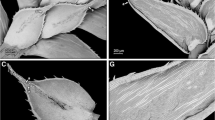Abstract
The stelar structure ofAsplenium obtusifolium and its related species (A. repandulum, A. riparium, A. triquetrum, A. volubile, A. purpurascens, A. ortegae, A. delitescens, A. hoffmannii, andA. laetum) in the New World tropics was observed and compared to that of Asian species ofAsplenium sect.Hymenasplenium. Both of the groups were found to share peculiar stelar structures: steles with two meristeles, a broader ventral and a narrower dorsal, each providing one of the two leaf traces; leaf gaps arranged in two rows between the dorsal and ventral strands, which are connected by thin meristeles, delimiting the leaf gaps. These structures are distinct from the radial symmetrical ones general inAsplenium. Together with cytological evidence, this strongly indicates that the New and Old World groups are closely related. Thus, these Neotropical species should be included in sect.Hymenasplenium.
Similar content being viewed by others
References
Hayata, B. 1927. On the systematic importance of the stelar system in the Filicales, 1. Bot. Mag. Tokyo41: 697–718.
Iwatsuki, K. 1975. Taxonomic studies of Pteridophytes X. Acta Phytotax. Geobot.27: 39–54.
— andM. Kato. 1975. Stelar structure ofAsplenium unilaterale and its allied species. Kalikasan4: 165–174.
Kato, M., N. Nakato, S. Akiyama andK. Iwatsuki. 1990. The systematic position ofAsplenium cardiophyllum (Aspleniaceae). Bot. Mag. Tokyo103: 461–468.
Mettenius, G. 1864. Über den Bau vonAngiopteris. Abh. Sachs. Ges. wiss.6: 501–570.
Mitsuta, S., M. Kato andK. Iwatsuki 1980. Stelar structure of Aspleniaceae. Bot. Mag. Tokyo93: 275–289.
Mitui, K., N. Murakami andK. Iwatsuki. 1989. Chromosomes and systematics ofAsplenium sect.Hymenasplenium. Amer. J. Bot.76: 1689–1697.
Murakami, N. andS.-I. Hatanaka. 1988. Chemotaxonomic studies ofAsplenium sect.Hymenasplenium (Aspleniaceae). Bot. Mag. Tokyo101: 353–372.
Murakami, N. and R.C. Moran. 1992. Monograph of the Neotropical species ofAsplenium sect.Hymenasplenium (Aspleniaceae). Ann. Missouri Bot. Gard.70. (In press).
Smith, A.R. 1976.Diplazium delitescens and the Neotropical species ofAsplenium sect.Hymenasplenium. Amer. Fern. J.66: 116–120.
— andJ.T. Mickel. 1977. Chromosome counts for Mexican ferns. Brittonia29: 391–398.
Tryon, R.M. andA.F. Tryon. 1982. Ferns and Allied Plants with Special Reference to Tropical America. Springer-Verlag, New York.
Author information
Authors and Affiliations
Rights and permissions
About this article
Cite this article
Murakami, N. Stelar structure ofAsplenium obtusifolium and its allied species in the New World tropics, with comparison to the Asian members ofAsplenium sect.Hymenasplenium . Bot Mag Tokyo 105, 135–147 (1992). https://doi.org/10.1007/BF02489409
Received:
Accepted:
Issue Date:
DOI: https://doi.org/10.1007/BF02489409




